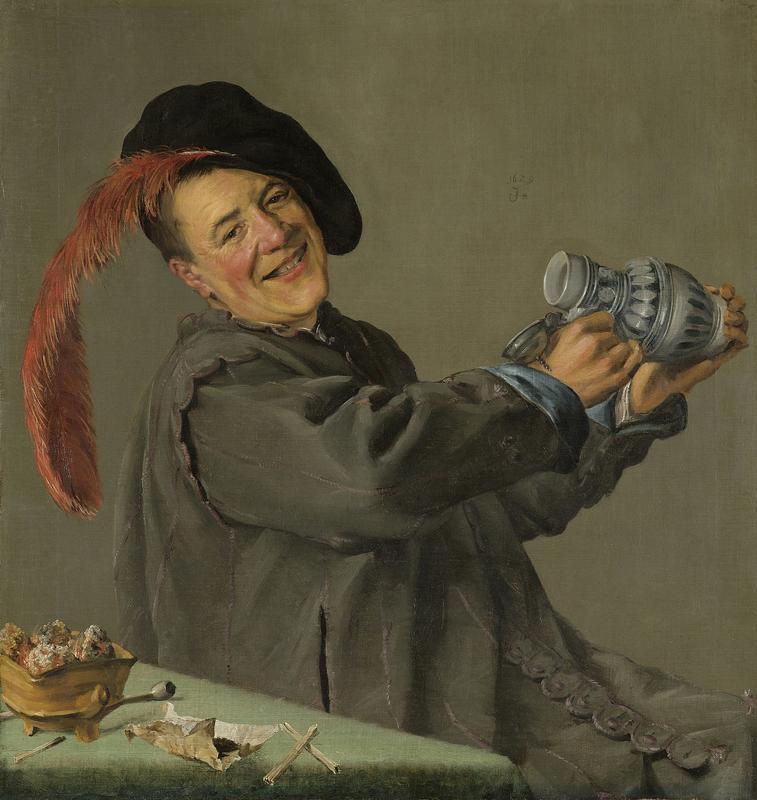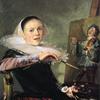More about The Jolly Drinker

Contributor
There’s something universal about Judith Leyster’s Jolly Toper, despite the fact that it was released in 1629.
My guy is just out here enjoying life. Look at him. We can all relate to that elation on his face. That was me on Christmas when I had my first piece of sweet potato pie. Jolly Toper is one of Leyster’s earliest paintings. But for years, it was believed to be done by someone else. Frans Hals, Judith Leyster’s mentor was the assumed painter as it was completed during her time under his study, and it resembles Hals’ work thematically. But the combined “JL” accompanied with a star was found signed not far from this very jovial man. “Leyster” roughly translates to “lead star” in Dutch. It serves as the inspiration for her unique signature. And since historians had seen that mark on her other paintings, it was a no brainer that Jolly Toper belonged to her, not her mentor. Sorry Frans.
We’re no stranger to smiling in pictures in the 21st century. It’s one of the many ways we can cultivate a significant social media following. But smiling during a portrait in the mid 1600s is different than taking a selfie. People didn’t smile in portraits often because the process took too long. Look at the Mona Lisa. She has a slight smirk, but that’s it. Sorry Leonardo, but I can’t keep this grin going for 16 hours straight. Portraits like that went a long way toward convincing people hundreds of years later that people in the past just weren’t happy. So the fact that the man in Jolly Toper is smiling as wide as he is, is definitely deliberate, as he would stand out in a room full of other portraits from the 17th century. But why he is happy is where things suggest that maybe Leyster is implying something else altogether.
At first glance, this guy is just completely, utterly, unabashedly full of joy. But there’s a source to this man’s glee hiding in plain sight. You can start with the hat. We may have pretty laxed views in the 21st century when it comes to fashion and the purpose for certain articles of clothing. But back then, things were much stricter. The hat on this man is not doing its job even a little bit. It’s off kilter. It looks like the type of hat T.I. would have worn in the mid 2000s. This dude would stand out in a crowd because of this. Then you look at his cheeks, it all starts to become clearer. Those are some red cheeks. And I don’t think my guy is cold. He appears to be indoors and he’s fully clothed. The redness in his cheeks, and the crookedness of his hat can most likely be attributed to the alcohol in his cup. Or rather, the alcohol that used to be in his cup. He’s tipping that thing to the side like there’s nothing but a drop or two left. And he’s holding it out like he wants more.
If you look at the table, you’ll see a pipe and some substance in open wrapping paper. It could be tobacco. It could be marijuana. It could be pixie stix. We’ll never know for sure. But whatever it is, it’s also a contributing factor to this dude’s present blissful state.
Leyster clearly, and seemingly objectively conveys a corner of life’s pleasure that most of us can relate to. At the end of the day, it’s up to the viewer if they think there is more being said. Jolly Toper can be looked at as a man who is just indulging in an afternoon of some light fun. Or it can be viewed as an overindulgence in too many vices at once. I’m not sure what Leyster was trying to say, if anything. Everything in this painting is without a doubt a deliberate choice, but it isn’t necessarily there to guide you to one conclusion or another. That’s the beauty of art.
Sources
- Broyard, Anatole. “Don’t Bother Me-- I’m Working.” The New York Times. June 28, 1973. https://www.nytimes.com/1973/06/28/archives/dontbother-me-im-working-bo…
- Encyclopedia. Leyster, Judith (1609-1660)” Accessed December 21, 2019. https://www.encyclopedia.com/women/encyclopedias-almanacs-transcripts-a…
- The Art Story. “Judith Leyster Artworks” Accessed December 21, 2019. https://www.theartstory.org/artist/leyster-judith/artworks/
Featured Content
Here is what Wikipedia says about Jolly Toper
The Jolly Toper is a 1629 oil painting by the Dutch artist Judith Leyster in the collection of the Rijksmuseum that is on long-term loan to the Frans Hals Museum since 1959. It was acquired by the museum as a painting by Frans Hals and was attributed to Leyster by the researcher Juliane Harms in 1927.
Check out the full Wikipedia article about Jolly Toper












